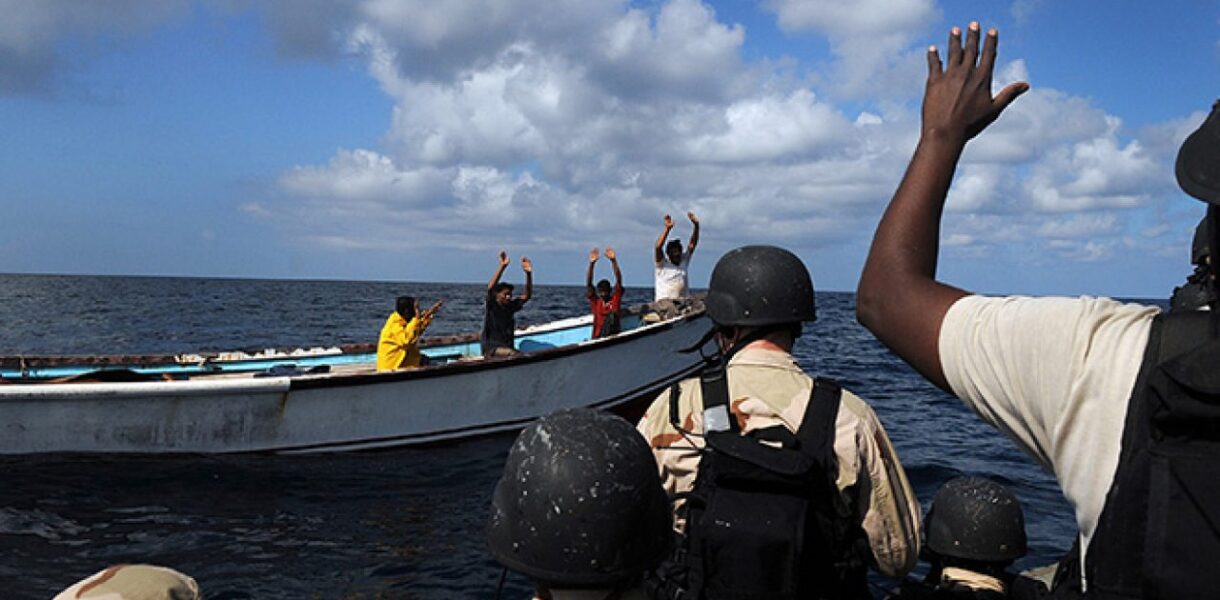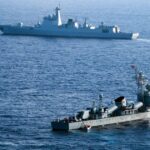

The right of a state to pursue a vessel belonging to a foreign state which has violated any violated any law within the territorial boundaries and jurisdiction is considered as doctrine of Hot Pursuit in international law. The doctrine vests a right to pursue the delinquent vessel outside the territorial limits into the open sea and then can be taken into custody. The fundamental rule of the maritime law states that all vessels have the right to navigate freely on the high seas. Yet, the traditional notion has recognized the doctrine of hot pursuit as an exception to the principles of freedom on the high seas. The doctrine is not a new one and has a long history in the international maritime law. Article 23 of the Geneva Convention on the High Seas, 1958 codified the concept of hot pursuit. The same was also adopted by the United Nations Law of the Sea Conventions under Article 111.
Over the years concept of hot pursuit has developed a lot. In the present time, the latest technology is used for the surveillance of the coastal borders of a country. But there was huge difference in the early era. The traditional view of the concept of hot pursuit developed largely during the canon shot era where certain procedural rules were to be followed. These procedures are often invoked to limit the use of some essential and sophisticated technology.
The state derives the right of hot pursuit from the customary principles of international law. This right can be seen as an exception to the principle of exclusive flag jurisdiction on the high seas. The doctrine also represents a transgression upon the sovereignty on the flag of a foreign state as the offending vessel can be pursued even beyond the maritime zones. This right lies somewhere between the principles of free navigation on the high sea and interest of state in effective governance of their coastal borders. The right given by the doctrine promotes in upholding public order by minimizing conflicts.
Flag state jurisdiction: – The high seas have relatively far-reaching freedoms for all states. there must however be some kind of maintenance of order and jurisdiction to avoid these freedoms to get violated and wrongful use by any state and so that wrongful acts on the high seas do not go unpunished. The main rule is that the state which has granted to a ship the right to sail under its flag (the flag state) has the exclusive right to exercise legislative and enforcement jurisdiction over its ships on the high seas. It is accordingly the flag state that enforces the rules and regulations of its own municipal law as well as international law.
In the Lotus-case (1927) where the Permanent Court of International Justice held that “vessels on the high seas are subject to no authority except that of the state whose flag they fly”, the general principle that the flag state alone may exercise jurisdictional rights over its ships was elaborated in the case. The flag state-principle is nowadays also stipulated in article 92 UNCLOS (and article 6 GCHS), where it is stated that ships must sail under the flag of one state only and that they will, as a general rule, be subject to that state’s exclusive jurisdiction on the high seas. Each state sets up its conditions for the grant of its nationality to ships, for registration of ships and for the right to fly its flag. This was declared by the International Tribunal for the Law of the Sea in the M/V Saiga (No.2) case, where one concluded that the determination of the criteria and procedures for granting and withdrawing nationality to ships are parts of the flag state’s exclusive jurisdiction.
The nationality of the ship depends accordingly upon the flag the ship flies, but there must be a genuine link between the state and the ship. The requirement of a genuine link was intended to counter the use of flags of convenience (often operated by states such as Liberia and Panama) where states grant their nationality to ships looking for favorable taxation and work- and social agreements. However, if a ship sails under the flags of more than one state according to convenience, the ship does not have any nationality in a juridical point of view and may therefore be boarded and seized on the high seas by any state. This is to be compared with ships that do have a flag, which (as a general rule) only can be boarded and seized by its own flag state on the high seas.
Worth mentioning is that there are also some duties and responsibilities attached to the flag state jurisdiction, such as the obligation to legislate to make it an offence to break or injure submarine cables and pipelines under the high seas. Furthermore, the flag state also has to provide for compensation in case such an offence occurs and to adopt and enforce legislation dealing with assistance to ships in distress in compliance with international duties regarding safety at sea.
The exclusivity of the flag state-principle is applicable without exception when it comes to warships and ships owned or operated by a state where they are used only on governmental non-commercial service. These ships have complete immunity from the jurisdiction of other states than its flag state according to the article 95 and article 96 of UNCLOS. Though, the principle of flag state jurisdiction on the high seas is not absolute.
Even though the exercise of the right of hot pursuit interferes with the principle of free navigation, doctrine of hot pursuit can only be exercised against a vessel which has violated the coastal laws of a different State and there is a very sound reason to believe that there has indeed been a violation. Hot pursuit does not pose any great threat to the principle of free navigation as it is seldom used by the States if we see it in the long term.
THE RATIONALE BEHIND THE DOCTRINE OF HOT PURSUIT
Maritime hot pursuit evolved as a customary international law doctrine before being first codified into an international treaty by art 23 of the 1958 Geneva Convention on the High Seas (the High Seas Convention). The doctrine was reproduced, in essence unchanged, in art 111 of UNCLOS. Thus, the doctrine enjoys “all the sanction of modern state practice and opinion”. UNCLOS provides the primary constitution for the oceans. On the one hand, it regulates the rights and duties of coastal states in the various maritime zones under their sovereignty. On the other, it codifies the freedom of navigation within coastal waters – such as the rights of innocent, transit and archipelagic sea lanes passage – and the freedom of navigation through the exclusive economic zone (EEZ). Thus, UNCLOS continues to seek a balance between the rights of coastal states to control their maritime areas and the rights of maritime states to enjoy the freedom of navigation over the ocean.
Conflict between coastal and maritime states – including disputes over the distinction between maritime zones and the high seas – has been a dominant theme throughout the history of the law of the sea. While one of the most important freedoms of the high seas is the freedom of navigation, equally paramount is the principle that ships on the high seas are subject exclusively to the jurisdiction of their flag state. Exceptions to this exclusivity rule may only be invoked in exceptional circumstances.
The right of hot pursuit is one such exception to exclusive flag state jurisdiction, with the predominant rationale being that the high seas should not be a safe haven for those who attempt to escape the lawful jurisdiction of another state.
Reuland argues that: Limiting a state’s enforcement jurisdiction to its marginal seas would needlessly foil the state’s interest in the enforcement of its laws. There is simply no good reason to throw up a barrier to pursuit at the line dividing the state’s territorial waters from the high seas. Pursuit onto the high seas offends the territorial sovereignty of no state. Nor does hot pursuit unduly offend the principle that ships on the high seas are subject to the exclusive jurisdiction of their flag state. Only escaping ships that at one time properly fell within a state’s territorial jurisdiction are exempted from the exclusivity rule.
However, the right of hot pursuit ceases when the fleeing vessel enters the territorial waters of its flag state or those of a third state. In these circumstances, pursuing a vessel into another state’s territorial waters has traditionally been considered an unacceptable violation of that state’s sovereignty. Thus, the right of hot pursuit is seen as a pragmatic balance between the coastal state’s interest in enforcing its laws and the interests of the international community in the freedom of the oceans and the integrity of territorial jurisdiction.
CONDITIONS FOR THE INITIATION OF DOCTRINE OF HOT PURSUIT
Few conditions are needed to be fulfilled before a hot pursuit can be initiated by the State. They are: –
- Good Reason
According to the guidelines given under the UNCLOS it is required that there should be good and sufficient reason to believe that foreign vessel has violated the law within its territorial water.
The phrase ‘good reason’ means that there should be more than a mere suspicion that an offence has been committed by the vessel. The reason should be based on a strong sign or indication. The right of hot pursuit is limited not only to a committed offence. The right can also be exercised in the case of attempted offence by a foreign vessel.
The Australia-France Treaty provides, among other things, that a “good reason to believe” may include:
i. direct visual contact with the fishing vessel or one of its boats by the authorized vessel; or ii. evidence obtained by or on behalf of the authorized vessel by technical means.
Such “technical means” might include radar or satellite imagery and aerial photography that could not only show the vessel’s location but also track movements consistent with fishing techniques. By providing specifically that evidence may be obtained through “technical means”, the Australia France Treaty recognizes the growing importance that coastal states are placing on technology in the surveillance and enforcement of their maritime zones.
- Commencement within the maritime jurisdiction if the state
When the foreign vessel commits any wrong either physically or constructively while it is under the jurisdiction of law enforcing state then a foreign vessel can be pursued. When any alien vessel violates any domestic law within the internal water or the contiguous zone then it can be pursued. The state also through specific legislations may include EEZs (exclusive economic zone) under the ambit of the doctrine. The UNCLOS also recognizes the right of hot pursuit in the continental shelf and safety zone around the continental shelf.
CHARACTER OF THE PURSUIT
1. Types of vessel
Only warships, military vessels and government vessels which are clearly marked and are identifiable can commence the hot pursuit. These vessels should be under the service of the government. This implies that naval submarines, enforcement vessels, coast guard vessels and ministry or defense or military vessels can exercise the right of hot pursuit. If the government especially authorizes any other vessel or aircraft to enforce law and order of the State, they can also exercise the right of pursuing the alien vessel provided that they are clearly marked as being under the service of the government.
2. Signal to stop
The enforcement vessel must give a signal to the alien vessel to stop implying that the alien vessel has been detected and is required to heave for boarding, before the commencement of hot pursuit. The UNCLOS stipulates that the order or signal to stop must be auditory or visual and it must be given from such a distance that the foreign vessel is able to hear or see the signal given by the enforcement vessel. Giving a signal to stop through a radio broadcast is a very debatable issue. When the 1958 Convention was drafted, it excluded radio signal. The reason for excluding radio signal was that there may be no limit on the distance from which a radio signal may be given.
3. Uninterrupted and continuous pursuit
The word interrupted has not been defined by the UNCLOS clearly but Article 111 of the UNCLOS states that the pursuit should be a continuous one as long it is not interrupted. The law states that that the first vessel or craft should continue pursuing the alien vessel until some other vessel or craft which has been sent by the coastal authorities or has been summoned by the pursuing vessel arrives at the spot and continue the pursue. There can be a few reasons for interruptions. There may be some mechanical or technical failure in the pursuing vessel due to which it is compelled to discontinue the hot pursuit, or due to any natural causes like darkness or bad climatic and weather conditions the pursuing vessel is forced to give up the chase or for any other reason like stopping to gather evidence left by the alien vessel or arrest any other small boats which are accompanying the alien vessel.
4. Pursuit must be immediate
While the very term “hot pursuit” implies that the pursuit must follow closely a violation of the coastal state’s laws or regulations, the immediacy of the pursuit is not an inflexible requirement. It should be interpreted in “a broader sense”. A key consideration is the action taken by the coastal state in initiating the pursuit. A vessel may have to seek authorisation from superiors or a land based headquarters before being authorised to commence a pursuit, or alternatively a vessel that is more appropriately equipped and crewed to conduct an arrest at sea may need to be summoned. These delays should not affect the legitimacy of any pursuit. Outside these general guidelines, however, whether the pursuit was immediate or not should depend entirely on an assessment of what is “reasonable” in the particular circumstances.
DOCTRINE OF CONSTRUCTIVE PRESENCE
REQUIREMENTS OF HOT PURSUIT
There are certain procedures which are required to be followed in accordance with the norms laid down in international laws to constitute a successful hot pursuit. One of the basic elements which are required is that the pursuit should be immediate. The phrase implies that the pursuit should be commenced as soon as possible after the offence is committed by the foreign vessel.
Article 111 of the UNCLOS also lays down certain conditions which need to be fulfilled to exercise the right validly.
- The State which is exercising its right under the doctrine must have sufficient and valid reason to believe that the foreign vessel has transgressed the law of the State.
- The pursuit must be started when the foreign vessel is within the internal waters, territorial sea, archipelagic waters, contiguous zone or Exclusive Economic Zone of the State.
- The pursuit can be commenced only after the foreign vessel has been given an auditory or visual signal to stop, which has been heard or seen by the foreign vessel.
- The right can be exercised only by authorized government vessels or warships which are identifiable and clearly marked.
- There should be no interruption in the pursuit.
- The right comes to an end when the offending vessel enters the territorial sea of its own jurisdiction or any third State.
TERMINATION OF HOT PURSUIT
A hot pursuit ends when the vehicle which is being pursued enters its own territorial jurisdiction or that of any third state. A hot pursuit also comes to an end when it is abandoned or is interrupted. The restriction which is placed is due to the fundamental rule of the sovereignty of the other state. Convention on the Law of Sea and High Seas also states that the hot pursuit must not be resumed when an alien vessel enters its own territorial jurisdiction or the territorial jurisdiction of a third state and subsequently returns to the high seas. Such provisions can be sometimes used intentionally by the alien vessels as evasive actions in case of a hot pursuit.
The rationale behind the rule that the right of pursuit ceases as soon as the pursued vessel enters the territorial sea of another state is that “to continue it therein would be to violate the sovereignty of the other state”.”‘ Furthermore, while all ships enjoy the right of innocent passage through the territorial sea of a foreign state,” pursuing a vessel through, or taking direct enforcement action in, the territorial sea would not fall within this right.”
JUSTIFICATION OF HOT PURSUIT
The Conventions of 1958 and 1982 do not list out any specific offences which justify hot pursuit. Therefore, it can be derived that whatever law the coastal state may want to enforce upon the foreign vessel can be done through hot pursuit provided that the law which the coastal state wants to enforce is legitimate. Before commencing the hot pursuit, the coastal state must determine the gravity and intensity of the offence committed by the foreign vessel and decides that whether it is really justified to transgress upon the freedom of navigation of the foreign vessel. There are few offences which do justify the right to hot pursuit like illegal drug trafficking is one of the issues which poses a grave threat to all the nations and requires strong and quick action to tackle the problem. Protection of the coastal borders of a nation against marine pollution and bio- degradation by foreign vessels is also one area where the coastal state may enforce the rules and regulations by going for a hot pursuit. A coastal state can commence a hot pursuit for the protection of its fisheries also as these are vital resources for the coastal state not only as a source of income but also as a source of food product and other additional industries.
DOCTRINE OF HOT PURSUIT AS AN ENFORCEMENT MECHANISM TO COMBAT MARITIME PIRACY
The maritime laws on Maritime Piracy and the Doctrine of Hot Pursuit raises an important question, i.e. Is Doctrine of Hot Pursuit relevant in the matter of Maritime Piracy? Article 100 of UNCLOS 1982 provides for international cooperation of all states in the repression of any activity related to maritime piracy, and Article 105 provides for universal jurisdiction to all states to deal with any vessel involved in the act of piracy. For such purpose, to combat piracy, relevant provisions of the piracy must be enacted as domestic legislation in the nation too. UNCLOS requires adoption of relevant provisions as domestic legislations by the member states. To facilitate the said process, IMO resolutions have been adopted containing precise guidelines and recommendations on implementing the said relevant provisions of the convention. A lot of members states have already adopted the relevant provisions as their domestic legislations.
The main purpose behind the adoption is enabling the member states to invoke the Doctrine of Hot Pursuit against a pirate ship without any confusion as to the capacity to invoke the said doctrine or as to the jurisdiction to invoke the said doctrine. While UNCLOS 1982 provides for repressing piracy, the said universal jurisdiction extends only on the high seas and places which are outside the jurisdiction of any state. Even though it can be said to extended to EEZs of the states, the jurisdiction is still limited. Thus, on adoption of the relevant provisions of piracy as domestic law by the member states, the jurisdiction becomes whole and limitless, especially when read with Article 100 and Article 105 of the UNCLOS 1982. In case a pirate vessel is found in the territorial waters of the state Doctrine of Hot Pursuit can be invoked, and thus the said ship can be pursued on to the High Seas and even on to the Contiguous zones of other states. Furthermore, even if the pirate ship enters the territorial waters of another state, since Article 100 calls for international cooperation, and Article 105 provides for universal jurisdiction, and since the provisions of piracy would have been enacted as domestic laws, another hot pursuit can be commenced by the said state. Furthermore, as Article 111(6)(b) provides for relayed hot pursuit, and if multi-lateral hot pursuit is permitted under the same, the pursuit shall continue till the said pirate vessel is captured since it would be left with no place to escape to. Hence, Articles 100 to Article 111 can be read harmoniously for a much more effective means of addressing the issue of maritime piracy.
USED OF FORCE ALLOWED IN HOT PURSUIT
Under the International law, the coastal state is justified in using force during a hot pursuit. But the use of force is only to be limited to a certain extent and only as much as necessary. Also, force should be used as a last resort. The necessary amount of force can be exercised by the coastal state even if it in any manner infringes the freedom of the alien vessel on the high seas. But excessive and unwarranted force will not be considered justice.
In the case of I’m Alone, the Commission held: The United States was permitted to use necessary and reasonable force for the purpose of effecting the objects of boarding, searching, seizing and bringing into port the suspected vessel; and if sinking should occur incidentally, as a result of the exercise of necessary and reasonable force for such purposes, the pursuing vessel might be entirely blameless.
CONSEQUENCES OF UNJUSTIFIED HOT PURSUIT
For the efficient implementation and enforcement of international law, it is of vital importance that all nations respect the rule of law. If the right given by the doctrine of hot pursuit is exercised in a wrong manner it reflects badly upon the rule of law which might cause a discord between the nations. The state which has engaged itself in any kind of unjustified hot pursuit should compensate the foreign vessel owners for their losses. The 1982 Convention states that according to the natural principle of the customary international laws, freedom of high seas is of vital importance.
UNCLOS art 111(8) provides that if a ship has been stopped in circumstances where the right of hot pursuit was not justified then “it shall be compensated for any loss or damage that may have been thereby sustained”. There is also the possibility of further recourse through arts 110(3) and 304. It has been suggested that, because of these provisions, coastal states are unlikely to abuse the right of hot pursuit. Nevertheless, these recourses are only available for states, not natural persons, and so the owners of the vessel would first, have to convince their flag state to instigate proceedings. They would also need to exhaust local procedures. The whole process, therefore, is likely to be expensive and time consuming. Furthermore, the unlawful exercise of the right of hot pursuit has not prevented some coastal states from commencing criminal prosecutions against the offenders, nor has it affected the admissibility of any evidence obtained as a result of the hot pursuit.
CONCLUSION
The doctrine of hot pursuit is of vital importance to the international law and is a firmly anchored concept. But since many factors are included in the exercise of this right and the doctrine is an exception to the fundamental rule of free navigation in the high seas, it should be exercised with utmost caution. The doctrine allows coastal states to protect their own sovereignty by preventing or stopping an alien or foreign vessel from committing an offence in the coastal state’s territory.
The fundamental of the doctrine is still founded on the rules and procedures of the old era where sophisticated technology and mechanism was not involved in the governance of a nation. The doctrine of hot pursuit should also evolve with the changing time if it is to prove effective and enforceable in the long run. Where the expansion of maritime rules, regulation and laws is in question, it is important to bring these new technologies and mechanism under its ambit as they have now become an indispensable part of the society. To maintain the viability of the doctrine in the 21st century the fundamentals of the doctrine must be allowed to expand and evolve.
Photo Source: Matthew Bash/US Navy — Getty Images
About The Author
Vaibhav Vishal is 3rd year law student, currently pursuing B.B.A., LL.B. (Hons.) from Chanakya National Law University, Patna.Muskan Kumari is the co-author is 2nd year law student, currently pursuing B.B.A., LL.B. (Hons.) from Chanakya National Law University, Patna.
BIBLIOGRAPHY
- Geneva Convention on the High Seas (1958) (opened for signature 29 April 1958) 450 UNTS 82,entry into force 30 November 1962
- U.N. PUB. no. e.83.V.5(1983), Montague Bay, December 10 1982.
- Article 111 is almost identical to Article 23, except that it allowed the right of hot pursuit from theEEZ as well as the continental shelf. Article 23 of the Geneva Convention did not address hot pursuitfrom the EEZ or the continental shelf, and as such, a right of hot pursuit from these areas did not existunder customary international law at that time.
- The Condition for Initiating, Maintaining, and Purpose of Hot Pursuit under International Maritime Law: Recommended Reforms for the 21st Century. Captain N PradeepRathnayake RWP RSP PscMMaritime Pol, Head Of Training Team ( Naval Wing), Defence Services Command and Staff College, Sapugaskanda.
- N Poulantzas, The Right of Hot Pursuit in International Law, 2nd Edition, The Hague, MartinusNijhoff Publications, 2002. ISBN- 9004117865.
- M. McDougal and W. Burke, Public Order of the Oceans, 894 (1987).
- RJ Baird., “Arrests in Cold Climate (Part 2): Shaping Hot Pursuit through State Practice,” Antarctic and Southern Ocean Law and Policy Occasional Papers, No. 13, 2009, p6.
- UNCLOS, Article 111(1).
- UNCLOS, Article 111(1) and (4).
- UNCLOS, Article 111(1) and (2).
- UNCLOS, Article 111(5).
- VasiliosTasikas, “Unmanned Aerial Vehicles and the Doctrine of Hot Pursuit: A New Era of Coast Guard Maritime Law Enforcement Operations,” Tulane Maritime Law Journal, Vol. 29, 2004, p. 72.
- James Marissen, “Hot Pursuit or No Pursuit? The F.V. South Tomi Arrest in 2001” Australian and New Zealand Maritime Law Journal, Vol. 16, 2002, p. 77.
- Fenrick, Legal Limits on the use of Force by Canadian Warships in Law Enforcement, 1980, Canadian Y.B.A, International L.
- The I Am Alone Case, 7 I.L.R. 203 (1935), U.S./Canadian A.R.B. Commission.




